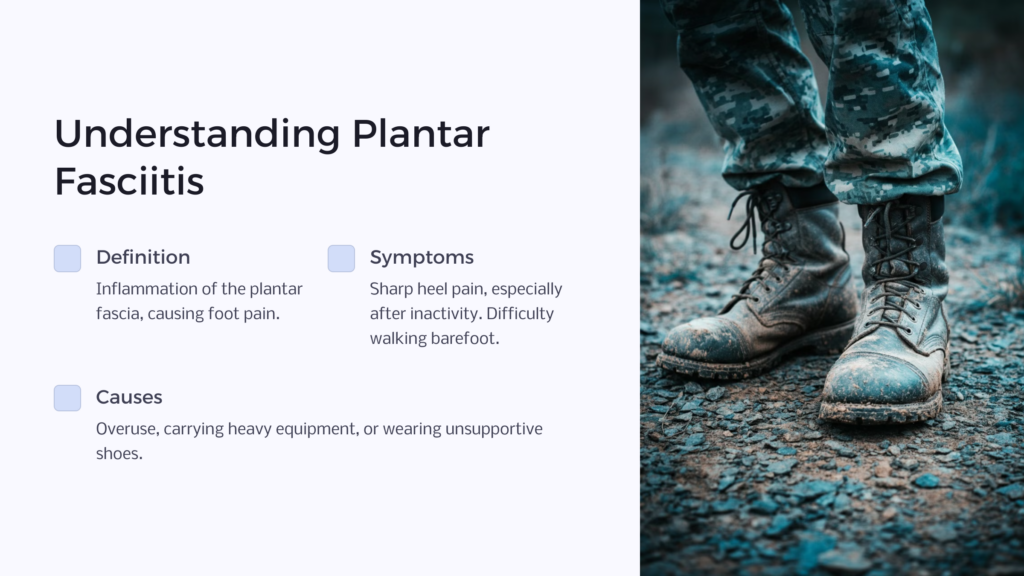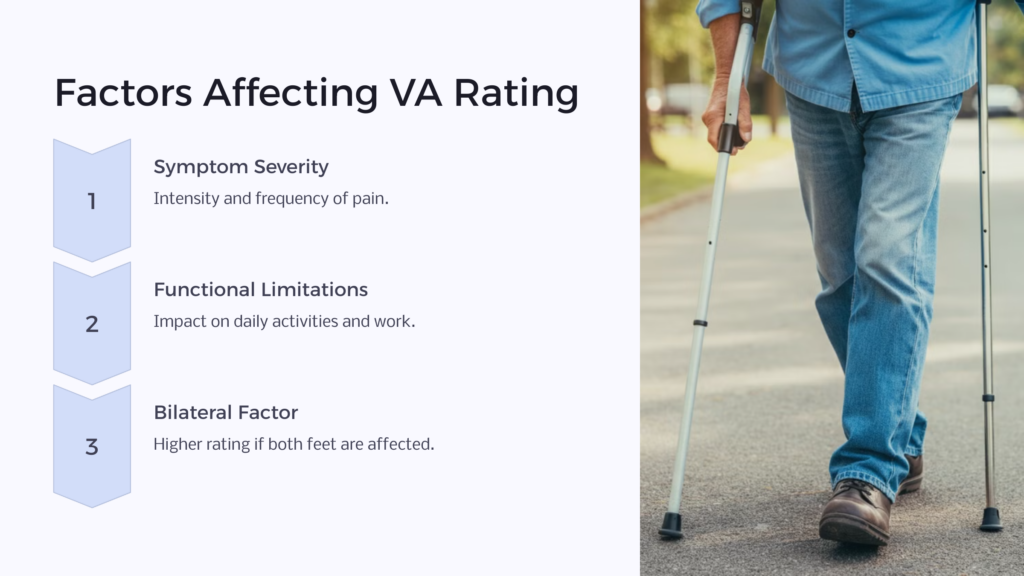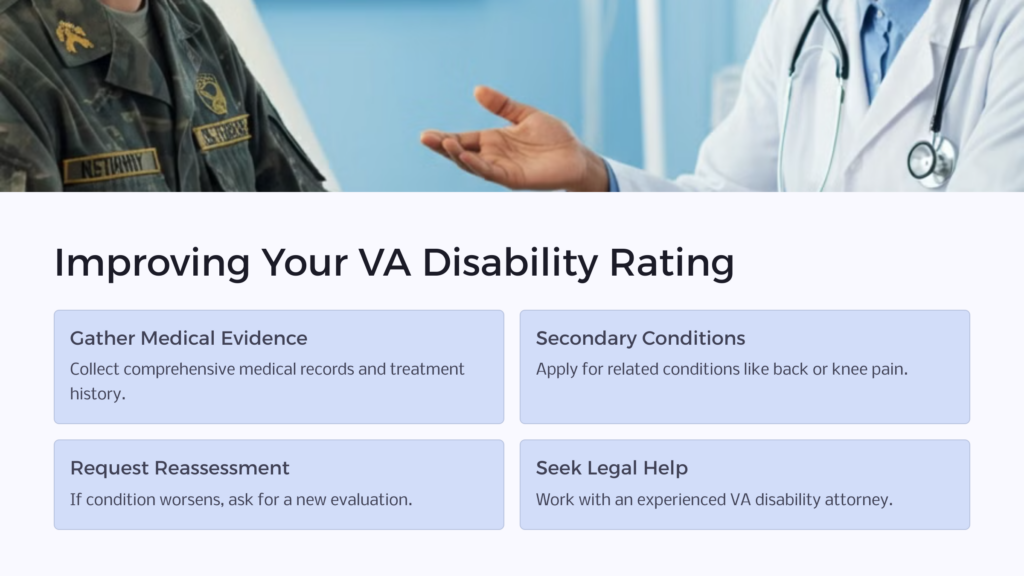Plantar fasciitis, also referred to as neuritis, runner’s heel, or painful sole syndrome, is a foot condition affecting many people, especially military veterans. This is an excruciating foot condition resulting from inflammation in the fascia – or connective tissues – connecting the toes to the heel bone. People suffering from this condition often experience mild to severe pain at the bottom of their feet. The pain might be so intense it is impossible to put any weight on the feet.
Many veterans suffer from health problems due to their military service, and plantar fasciitis pain can significantly affect their everyday lives. In fact, recent research shows high rates of this condition in Army and Marine service members, especially among female veterans. Thankfully, the United States Department of Veterans Affairs (VA) appreciates the effects this condition has on veterans and their families and offers compensation to eligible veterans.
Understanding Plantar Fasciitis

Plantar fasciitis is a form of foot pain characterized by plantar fascia inflammation. This degenerative condition causes sharp pain in the foot’s arch, heel, or bottom.
The plantar fascia is a fibrous and tough tissue band extending across the feet’ soles. It’s attached to the heel bone and the base of the toes to encourage walking and food motion mechanics. You can think of it as the band of tissue supporting your foot’s arches.
The plantar fascia is strong. You exert a lot of stress or tension on it when you put your weight on your feet while walking, standing, or carrying heavy equipment. But if it experiences too much tension quickly or is overused, it can lose its resilience and elasticity, becoming inflamed, irritated, or even swollen.
These are the most common symptoms of heel pain:
- Minor or severe pain, which may start sharply or increase slowly, often occurs near the heel. Most people experience plantar fasciitis pain after prolonged periods of inactivity, especially when they get up after sleeping. Thus, this condition is sometimes referred to as “first-step” pain.
- Inability to move your heels or feet.
- Difficulty walking with bare feet or while wearing shoes with minimal support.
- Knee or leg pain as a secondary side effect. This condition causes you to change your walking patterns, exerting a lot of strain on your knees and legs.
Many potential issues cause pain and inflammation common to plantar fasciitis, including increasing your activity levels beyond your body’s norm or running too much. Further, some veterans might have irregularly shaped feet, making them more susceptible to this condition.
You can also suffer from this condition if you regularly carry heavy equipment, which may strain your plantar fascia and damage your tissue.
If you wear shoes that you’re uncomfortable in or those that aren’t correctly sized for your feet–for example, if you wear boots that don’t provide adequate support–you can also suffer from this condition with time.
Generally, many of the physical requirements or activities associated with serving in the military can lead to plantar fasciitis among veterans.
Fortunately, these self-care tips can help you ease the pain of plantar fasciitis:

- Wear supportive shoes: Shoes with low to moderate heels, good arch support, thick soles, and adequate cushioning can reduce the pain of this medical condition. Some people benefit greatly from the extra support found in orthopedic shoes. Avoid walking barefoot or wearing flats.
- Change your workout routine: Try low-impact workouts, like bicycling or swimming, instead of jogging or walking.
- Maintain a healthy weight to avoid exerting extra stress on your plantar fascia.
- Simple home exercises can stretch your calf muscles, Achilles tendons, and plantar fascia.
The Role of Veterans Affairs (VA)
The U.S. Department of Veterans Affairs is a federal agency that offers compensation, cemetery, and health care services to military veterans. It also administers compensation programs for military veterans, their families, and survivors.
The VA also administers tax-free monthly benefits to military veterans who became disabled because of service-connected illnesses or injuries. In addition, it offers disability benefits to veterans who suffer from pre-existing conditions that worsen due to military service.
There are many types of disability benefits, and eligibility depends on the specific type of compensation sought.
But to receive any type of veterans disability benefits, you must meet these conditions:
- Your service-related disability must have received a disability rating from the VA
- You must have served on active duty training, active duty, or inactive duty training.
Besides meeting the above conditions, you must also meet any of the following requirements:
- You became injured or sick during your military service or link your disability to your military service
- You had a pre-existing illness or injury that worsened from your military service
- You were diagnosed with an illness or injury after your military service
The VA’s compensation program covers various mental and physical conditions. Qualifications for these disability benefits depend on several factors, including your financial needs, the numerical disability rating assigned by the VA, and your military service time.
The process of filing a VA claim for disability entails:
- Establishing if you qualify for VA disability payments.
- Filing out your claim completely
- Gathering evidence and supporting documents you’ll need to prove your claim. This includes medical records, hospital records, and supporting statements from family, friends, colleagues, or clergy members. These statements and documentation will tell the VA about your claimed disability, how and when it occurred, and how it affects your daily life.
- Find out if you’ll need to submit your claim with additional forms.
The VA Rating System for Plantar Fasciitis
The VA considers the following criteria when assigning a rating for a plantar fasciitis disability claim:
- Current diagnosis of the foot pain by a podiatrist or general physician
- Proof and description of in-service incidents that caused foot injury or foot pain, which caused plantar fasciitis
- Evidence of how serving in the military caused or worsened your condition.
The VA historically evaluated plantar fasciitis under musculoskeletal injuries; however, in 2021, the condition received its diagnostic code. Currently, the maximum rating for plantar fasciitis is 40%, with various percentages assigned based on the seriousness of the veteran’s symptoms. Based on your symptoms and their severity, and whether both feet are affected, you’ll receive one of the following VA disability ratings:
- 10% disability rating applies to military veterans suffering from plantar fasciitis in one or both feet, and the condition is responsive to medical treatment.
- A 20% disability rating applies to veterans with plantar fasciitis that impacts one foot and isn’t responsive to medical treatment. “Not responsive to medical treatment” means one doesn’t get relief from surgical and nonsurgical medical treatments.
- 30% disability rating applies to veterans with plantar fasciitis that affects both feet, and it’s not responsive to medical treatment.
- A 40% disability rating applies to veterans with plantar fasciitis that causes foot loss. This type of plantar fasciitis is rated under the diagnostic code 5167.
Military veterans receive a higher VA disability rating for plantar fasciitis if their symptoms are very severe or if they have bilateral plantar fasciitis and their disability affects both feet.
Also, the VA allows a particular rating for military veterans who qualify for plantar fasciitis surgery but can’t undergo the procedure. Here, a disability rating of 20% or 30% is assigned based on whether the disability affects one or both feet.
If you have already received disability benefits and been diagnosed with this condition, you may be eligible for a VA disability increase. You can even receive benefits at the 100% VA disability rating if you have multiple disabilities that hinder you from working.
TDIU (Total Disability Individual Unemployability) benefits are also available to military veterans whose service-related disabilities hinder substantial gainful employment. You may qualify for TDIU benefits even if your individual disabilities don’t meet the VA’s conditions for a 100% disability rating.
To qualify for TDIU benefits, a military veteran generally needs a combination of conditions that add up to a 60% or higher rating. If a military veteran is awarded TDIU, they’re compensated at the 100% rating even though their VA disability rating is less than 100%. The primary consideration is that the combination of service-related conditions makes the veteran unable to work.
Factors Affecting the VA Rating for Plantar Fasciitis

The VA considers several factors when rating plantar fasciitis. These include:
- The severity of symptoms and pain level: Pain is one of the key symptoms of this medical condition and is a critical factor in determining the severity of plantar fasciitis. The VA assesses the intensity, frequency, and duration a veteran experiences pain, both during physical activity and at rest. Military veterans with severe and persistent pain that drastically affects their ability to stand, walk, or perform everyday activities are likely to receive a higher rating and, ultimately, more monthly benefits. The VA also considers the efficiency of various pain management strategies, including physical therapy, medications, injections, and orthotics, in easing a veteran’s symptoms. Suppose pain continues despite treatment and surgery, or the veteran experiences recurrent or chronic episodes of pain. That might warrant a higher rating to reflect the ongoing effect on their quality of life.
- Functional impediments: Functional limitations include an inability to perform various recreational activities, work, or everyday activities. The VA assesses how your disability affects your ability to perform essential tasks, like standing, walking, maintaining balance, or climbing stairs. Similarly, the VA considers the veteran’s ability to engage in sports, hobbies, or other recreational activities requiring physical exertion. Military veterans who experience substantial functional impediments because of this disability, such as difficulty standing for prolonged periods, walking long distances, or participating in physical activities, might be eligible for a higher VA rating. The VA considers the effects of these limitations on a veteran’s quality of life and ability to pursue vocational activities or maintain employment.
- Bilateral factor: When assigning a disability rating, the VA also considers if your condition affects both of your feet. According to the VA disability rating criteria, because bilateral disabilities are much more limiting, they result in higher levels of disability. Thus, veterans who meet bilateral disability rules receive a combined disability rating that’s 10% more than the two separate disability combined.
How to Improve Your VA Disability Rating for Plantar Fasciitis

To increase your VA disability rating, you’ll need to:
- Seek medical treatment and gather medical records to support your claim. One of the most critical factors in increasing a VA disability rating is providing comprehensive medical evidence that supports your disability claim. That medical evidence includes records from private doctors, military service, and VA medical providers. You must seek appropriate medical treatment and document all the symptoms and limitations of your plantar fasciitis. Apart from gathering medical evidence, you can also provide statements from family and friends that describe the nature and extent of your service-related plantar fasciitis. You can use medical evidence and statements from your family and friends to help the VA understand the impact of plantar fasciitis on your daily life and ability to work.
- Apply for secondary service connection for medial conditions related to plantar fasciitis. Secondary service connection is a form of VA disability claim that enables veterans to receive compensation for conditions caused or worsened by existing service-related disabilities. That means if you suffer from health issues that result or co-occur from plantar fasciitis, the VA may assign you a high disability rating, which means you’ll qualify for additional benefits for those related issues. VA secondary conditions to heel pain include back, knee, or hip pain, flat feet, balance issues, and bunions. To apply for a secondary service connection, you must provide medical documentation that proves the secondary condition is related to plantar fasciitis.
- Request a reassessment of the current disability rating. If you believe that your current VA disability rating is too low, request a reassessment of that rating. You can do that if your condition has worsened since your initial disability rating decision or if you believe that the decision was incorrect. To request reassessment, you must submit VA Form 21-526EZ. This is the Application for Disability Compensation and Related Compensation Benefits form. In your application, you must provide specific information about how your condition has worsened since the rating decision or why you believe the initial disability rating was incorrect. The VA will schedule a new examination to assess your current condition and establish if they should increase your rating.
- Work with an experienced VA attorney: An experienced VA disability lawyer can offer valuable assistance throughout the disability claim process. That’s because disability attorneys have immense knowledge of VA laws, regulations, and procedures governing disability compensation claims. They can guide you through the complicated process and ensure you receive the compensation you deserve. Also, a VA disability lawyer can help you collect and organize essential medical evidence, supporting documents, and treatment records to strengthen your compensation claim. Your lawyer can also help you prepare for C&P (compensation and pension) examinations by advising you on how to communicate your symptoms effectively, what to expect, and what medical evidence to present to the examining officers. Further, if you disagree with the VA’s decision on your rating or your disability claim is denied, your lawyer can represent you in the appeals process. They can file an appeal, submit additional documentation, and advocate on your behalf before the Board of Veterans’ Appeals or the VA.
Many veterans suffer from this debilitating condition; for instance, Harley Martinez, who served in the Marine Corps, suffered from plantar fasciitis after years of physical exertion and rigorous training. She sought medical treatment via the VA healthcare provider and was diagnosed with chronic plantar fasciitis. Luckily, her VA healthcare provider encouraged her to apply for VA disability compensation. She was initially hesitant, but her doctor assured her that she deserved compensation for her service-connected condition.
She submitted her disability claim with supporting documents, including statements describing the impact of her condition on her work and daily life and medical records. Thankfully, her claim was approved, and she received adequate disability benefits to cover her medical bills and help her move forward. Harley’s story underpins the importance of seeking medical treatment, collecting medical evidence, and working with experienced professionals when pursuing VA disability compensation.
Conclusion: Plantar Fasciitis VA Disability Rating
Plantar fasciitis is a severely debilitating condition that makes it challenging to engage in activities you love. Those suffering from this condition may experience acute or severe pain at the bottom of their feet. This pain can be severe, making it impossible to put minimal weight on your feet. If you’re a military veteran who has this condition, it can affect your VA disability rating.
The VA disability rating for plantar fasciitis considers several factors, like the severity of your symptoms and pain level, functional impediments, bilateral factors, and response to medical treatment. By providing comprehensive medical evidence and documentation to support your disability claim, including hospital records, medical documents, and statements from those close to you, you can increase your chances of receiving a higher disability rating.
Seeking legal assistance from an experienced VA disability attorney can also help streamline your disability claim process, increasing your chances of receiving the disability benefits you deserve.
 Benefits.com Advisors
Benefits.com Advisors
With expertise spanning local, state, and federal benefit programs, our team is dedicated to guiding individuals towards the perfect program tailored to their unique circumstances.
Rise to the top with Peak Benefits!
Join our Peak Benefits Newsletter for the latest news, resources, and offers on all things government benefits.



















